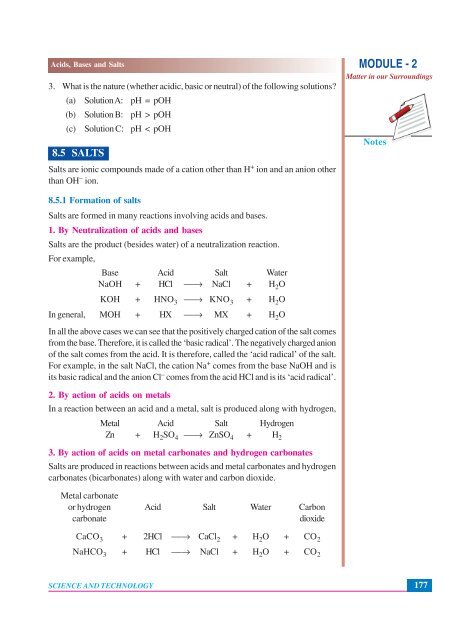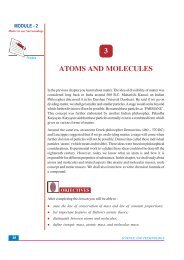8. Acids, Bases and Salts (41.1 MB)
8. Acids, Bases and Salts (41.1 MB)
8. Acids, Bases and Salts (41.1 MB)
You also want an ePaper? Increase the reach of your titles
YUMPU automatically turns print PDFs into web optimized ePapers that Google loves.
<strong>Acids</strong>, <strong>Bases</strong> <strong>and</strong> <strong>Salts</strong><br />
3. What is the nature (whether acidic, basic or neutral) of the following solutions?<br />
(a) Solution A: pH = pOH<br />
(b) Solution B: pH > pOH<br />
(c) Solution C: pH < pOH<br />
<strong>8.</strong>5 SALTS<br />
<strong>Salts</strong> are ionic compounds made of a cation other than H + ion <strong>and</strong> an anion other<br />
than OH – ion.<br />
MODULE - 2<br />
Matter in our Surroundings<br />
Notes<br />
<strong>8.</strong>5.1 Formation of salts<br />
<strong>Salts</strong> are formed in many reactions involving acids <strong>and</strong> bases.<br />
1. By Neutralization of acids <strong>and</strong> bases<br />
<strong>Salts</strong> are the product (besides water) of a neutralization reaction.<br />
For example,<br />
Base Acid Salt Water<br />
NaOH + HCl ⎯→ NaCl + H 2 O<br />
KOH + HNO 3 ⎯→ KNO 3 + H 2 O<br />
In general, MOH + HX ⎯→ MX + H 2 O<br />
In all the above cases we can see that the positively charged cation of the salt comes<br />
from the base. Therefore, it is called the ‘basic radical’. The negatively charged anion<br />
of the salt comes from the acid. It is therefore, called the ‘acid radical’ of the salt.<br />
For example, in the salt NaCl, the cation Na + comes from the base NaOH <strong>and</strong> is<br />
its basic radical <strong>and</strong> the anion Cl – comes from the acid HCl <strong>and</strong> is its ‘acid radical’.<br />
2. By action of acids on metals<br />
In a reaction between an acid <strong>and</strong> a metal, salt is produced along with hydrogen,<br />
Metal Acid Salt Hydrogen<br />
Zn + H 2 SO 4 ⎯→ ZnSO 4 + H 2<br />
3. By action of acids on metal carbonates <strong>and</strong> hydrogen carbonates<br />
<strong>Salts</strong> are produced in reactions between acids <strong>and</strong> metal carbonates <strong>and</strong> hydrogen<br />
carbonates (bicarbonates) along with water <strong>and</strong> carbon dioxide.<br />
Metal carbonate<br />
or hydrogen Acid Salt Water Carbon<br />
carbonate<br />
dioxide<br />
CaCO 3 + 2HCl ⎯→ CaCl 2 + H 2 O + CO 2<br />
NaHCO 3 + HCl ⎯→ NaCl + H 2 O + CO 2<br />
SCIENCE AND TECHNOLOGY<br />
177
















